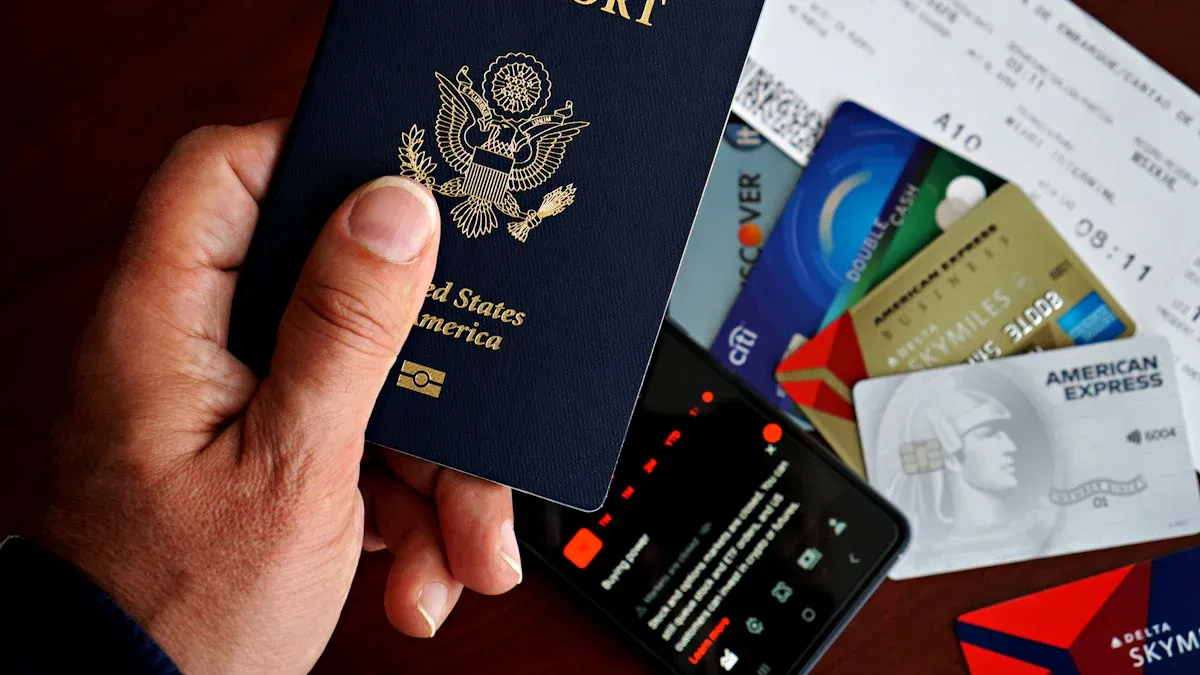- EasyCard
- Trade
- Help
- Announcement
- Academy
- SWIFT Code
- Iban Number
- Referral
- Customer Service
- Blog
- Creator
From KYC to Transaction Monitoring: Complete Guide to Cross-Border Payment AML Solutions

Image Source: pexels
Companies building effective cross-border payment anti-money laundering solutions must integrate four core pillars. These include identity verification (KYC), transaction monitoring, risk assessment, and ongoing due diligence. Technology, particularly artificial intelligence, plays a key role in automating and intelligently managing risks. It helps companies address increasingly complex global regulatory environments and evolving money laundering threats.
Global Money Laundering Data Alert The latest statistics show that money laundering activities pose a severe global challenge:
- In 2023, global money laundering amounts are estimated at up to 3.1 trillion USD.
- Nearly a quarter of these activities are related to Europe.
- Over 194.9 billion USD in laundered funds flow through cross-border transactions in Europe.
Facing such a severe situation, a robust cross-border payment solution is not only a compliance requirement but also a necessary defense for companies to protect themselves from financial crimes.
Key Takeaways
- Companies need to establish a complete anti-money laundering solution. This solution includes identity verification, transaction monitoring, risk assessment, and ongoing investigation.
- KYC and CDD are the foundation of anti-money laundering. They help companies confirm customer identity and assess money laundering risks.
- AI technology can help companies better conduct anti-money laundering. AI can automatically verify identities, identify suspicious transactions, and reduce errors.
- Companies must monitor transactions in real time. This can detect abnormal large transactions and money laundering patterns.
- Companies need to continuously optimize anti-money laundering systems. This includes dynamically assessing customer risks and submitting suspicious activity reports.
KYC and CDD: Building a Solid Foundation for Anti-Money Laundering

Image Source: pexels
Know Your Customer (KYC) and Customer Due Diligence (CDD) are the cornerstones of anti-money laundering compliance. Any cross-border payment business begins with accurate identification of customer identity. If there are loopholes in this link, subsequent transaction monitoring and risk management will be in vain.
KYC: The First Line of Defense in Cross-Border Payments
KYC is the identity verification process that companies must perform when establishing business relationships. Its core goal is to confirm that the customer is the individual or company they claim to be and to assess their potential money laundering risks. However, in a globalized context, executing KYC faces many challenges.
Main Obstacles in Cross-Border KYC
- Regulatory Differences: Laws and regulations vary significantly across countries and regions. For example, EU’s GDPR emphasizes data privacy, while U.S. regulations focus more on anti-money laundering itself, requiring companies to address these complex legal requirements simultaneously.
- Data Management: Cross-border transactions generate massive amounts of data. Companies need to securely manage this information within strict time limits, or they may face huge fines due to reporting errors or delays.
- High Costs: Traditional KYC processes relying on manual review are not only inefficient but also require significant manpower and financial investment.
eKYC: AI-Driven Automated Identity Verification
Electronic KYC (eKYC) uses technical means to automate and intelligentize the identity verification process. Artificial intelligence (AI) plays a central role in it, efficiently identifying forged information and preventing identity theft. AI-driven systems improve accuracy in the following ways:
- Document Authenticity Analysis: AI algorithms can analyze ID documents in real time, detecting tampering traces imperceptible to the human eye, such as pixel distortion or inconsistent fonts.
- Biometric and Liveness Detection: The system prompts users to complete specified actions like blinking or turning their head, combined with 3D facial recognition technology, effectively resisting fraud attacks using photos, videos, or 3D masks.
- Cross-Data Verification: AI platforms cross-compare the name submitted by the customer, ID photo, and liveness detection results to ensure consistency among the three, thereby completing high-precision identity verification.
CDD/EDD: From Standard to Enhanced Due Diligence
Customer Due Diligence (CDD) is the ongoing assessment of customer risks based on KYC information. For most customers, Standard Due Diligence (CDD) is sufficient. However, once high-risk signals are identified, companies must initiate Enhanced Due Diligence (EDD). Common conditions triggering EDD include:
- The customer is a Politically Exposed Person (PEPs) or their associate.
- The customer comes from high-risk countries or regions identified by the Financial Action Task Force (FATF).
- The corporate customer has an abnormally complex ownership structure, making it difficult to trace the ultimate owner.
- Abnormal transaction patterns, such as sudden large transactions inconsistent with the customer’s background.
Failure to effectively perform due diligence will lead to severe consequences. For example, HSBC was fined up to 1.9 billion USD due to major defects in its anti-money laundering system.
UBO Penetration: Identifying Beneficiaries Behind Shell Companies
Identifying the Ultimate Beneficial Owner (UBO) is the most challenging part of corporate customer due diligence. Criminals often use complex methods to hide true identities, such as:
- Setting up multi-layered shell companies across multiple jurisdictions.
- Appointing nominal directors or using vague job titles to conceal actual controllers.
- Using trust agreements to separate legal ownership from actual beneficial rights.
To address these challenges, modern anti-money laundering solutions leverage technology to penetrate complex corporate structures. AI-driven verification platforms can integrate corporate registration data from over 100 countries or regions, automatically analyze ownership chains, and compare in real time with sanctions lists, helping companies efficiently and accurately identify UBOs hidden behind the scenes.
Intelligent Risk Control: Building Efficient Cross-Border Payment Solutions

Image Source: unsplash
If KYC and CDD are the first static defense line in anti-money laundering, then intelligent risk control systems are the dynamic second defense line. They are responsible for reviewing every transaction in real time to identify hidden money laundering risks. An advanced cross-border payment solution must have strong intelligent risk control capabilities to effectively intercept illegal fund flows without affecting user experience.
Building Real-Time Transaction Monitoring Systems
In the cross-border payment field, speed and accuracy are equally important. Transaction monitoring systems must achieve near-instantaneous risk judgment without sacrificing compliance. To achieve this, modern systems typically have the following core capabilities:
- Sub-Second Detection Capability: The system uses real-time rule engines to complete transaction data analysis and risk scoring within milliseconds, ensuring smooth payment processes.
- High Availability and Scalability: System architectures (such as cloud-native microservices) support horizontal scaling to easily handle growing transaction volumes. At the same time, it must ensure over 99.9% uptime for 24/7 uninterrupted monitoring.
- API Rapid Integration: API-based interface design allows payment institutions to quickly integrate AML screening functions seamlessly into existing payment processes, shortening deployment cycles.
Leading payment solution providers, such as Biyapay, provide companies with low-latency, high-efficiency real-time transaction monitoring services by integrating these cutting-edge technologies, ensuring compliance checks do not become business bottlenecks.
Typical Money Laundering Pattern Recognition and Analysis
Money laundering methods continue to evolve, but some typical patterns remain the focus of regulatory attention. Intelligent risk control systems can automatically identify these suspicious behaviors through preset rules and machine learning models.
Beware! Common Cross-Border Money Laundering Methods
- Abnormal Large Transactions: Single or multiple large fund transfers completely inconsistent with the customer’s historical transaction patterns or business background.
- Underground Banking “Mirror Transactions”: This is a covert cross-border fund transfer method. For example, Customer A in mainland China hands RMB to the underground bank, which then pays equivalent USD or HKD to Customer A’s designated overseas recipient through its Hong Kong account, with funds not actually crossing borders but completing value exchange.
- Smurfing and Structuring: These are two similar but distinct methods to evade regulatory thresholds (such as the U.S. 10,000 USD).
| Method | Description | Goal | Example |
|---|---|---|---|
| Smurfing | Criminals recruit multiple “mules” to deposit small amounts at different times, locations, or through different accounts. | Makes fund tracking extremely difficult as transactions are dispersed across numerous seemingly unrelated accounts. | A criminal group divides 100,000 USD in illicit proceeds among 12 “mules,” each depositing less than 10,000 USD at different licensed Hong Kong banks. |
| Structuring | A single entity deliberately splits a large transaction into multiple small transactions, each slightly below the regulatory reporting threshold. | Specifically to avoid triggering mandatory suspicious activity reports (SAR) by financial institutions. | A business owner, to evade regulation, deposits 9,900 USD daily into the same account for several consecutive days to avoid reaching the 10,000 USD reporting standard. |
AI Empowerment: From Anomaly Detection to Behavior Analysis
Traditional rule-based monitoring systems easily generate a large number of “false positives,” consuming significant efforts from compliance teams. The introduction of artificial intelligence (AI) evolves risk control systems from “rule judgment” to “intelligent analysis,” greatly improving accuracy.
1. Intelligent Anomaly Detection Models
AI algorithms can learn “normal” transaction patterns from massive data to precisely identify “anomalies.” Commonly used models include:
- Isolation Forest: Quickly “isolates” anomalies by randomly partitioning data, especially suitable for high-dimensional data, widely used in financial fraud detection.
- Autoencoders: A neural network model that identifies anomalies by learning to reconstruct normal data. When the model cannot reconstruct a transaction well, it is flagged as anomalous.
- LSTM Networks (Long Short-Term Memory Networks): Specialized for time-series data, remembering customers’ long-term transaction habits to detect short-term anomalies inconsistent with history.
AI can not only detect single-point anomalies but also perform deep behavior analysis. It builds dynamic “behavior baseline profiles” for each customer to distinguish legitimate transactions from suspicious activities. For example, the system comprehensively analyzes the customer’s industry, transaction history, fund sources, counterparties, etc. When a small commodity trading company suddenly receives a large remittance from a high-risk region unrelated to its business, the behavior analysis system immediately flags it as a high-risk event because it severely deviates from the established behavior baseline. This method effectively identifies complex money laundering networks while significantly reducing interference with normal business activities.
Implementing Risk-Based Monitoring Strategies
The most efficient cross-border payment solutions do not apply “one-size-fits-all” to all customers but implement risk-based differentiated monitoring strategies (Risk-Based Approach, RBA). This means companies need to focus limited compliance resources on the highest-risk areas.
A typical tiered monitoring system is as follows:
| Risk Level | Customer Characteristics | Monitoring Strategy |
|---|---|---|
| Low Risk | Clear income sources, simple business, good compliance record. | Use standard transaction monitoring rules and conduct periodic data reviews. |
| Medium Risk | Customers from or transactions involving high-risk money laundering industries. | Initiate enhanced due diligence (EDD) and appropriately increase monitoring frequency and sensitivity. |
| High Risk | Complex ownership structures, involving politically exposed persons (PEPs), abnormal transaction patterns. | Implement the strictest ongoing monitoring, with all large or abnormal transactions requiring manual review and verification of fund sources. |
In this way, companies can ensure compliance baselines while providing smoother payment experiences for the vast majority of low-risk customers. Automation tools (such as the risk scoring engine provided by Biyapay) can dynamically adjust risk ratings based on customer data and transaction behavior, helping companies intelligently allocate monitoring resources to achieve the best balance between security and efficiency.
Sanctions Screening: Avoiding Sanctions and Compliance Risks
Transaction monitoring systems review transaction behavior, while sanctions screening focuses on reviewing counterparty identities. It is an indispensable part of anti-money laundering solutions, ensuring companies do not transact with sanctioned individuals, entities, or countries. Any negligence can place companies at huge legal and financial risks.
Why Sanctions Screening Is Necessary
The core goal of sanctions screening is to prevent illegal funds from entering the global financial system and cut off funding sources for terrorist organizations and sanctioned regimes. For cross-border payment companies, strict sanctions screening is not only a compliance obligation but also key to protecting their business security.
Severe Consequences of Violating Sanctions Companies failing to comply with sanctions face severe consequences. These are not limited to financial losses but can shake the foundation of business survival:
- Huge Fines: Fines imposed by regulators can wipe out years of profits.
- Reputational Damage: Enforcement actions severely damage brand reputation, leading to loss of customers and partners.
- Legal Accountability: Continuing business with sanctioned entities may lead to harsher legal and financial sanctions.
Core Sanctions Lists Screening: OFAC, UN, and EU
There are multiple authoritative sanctions lists globally that payment institutions must screen in real time. The most core lists include:
| List Name | Issuing Authority | Description |
|---|---|---|
| OFAC List | U.S. Treasury Department Office of Foreign Assets Control | Most globally influential, covering Specially Designated Nationals (SDN), etc. |
| UN Consolidated List | United Nations Security Council | Targets individuals and entities threatening international peace and security. |
| EU Consolidated List | European Union | Applies to all EU member states, restricting transactions with the EU. |
Companies need to ensure their screening systems can synchronize updates to these lists in real time to avoid compliance vulnerabilities due to information delays.
Screening Technology: From Exact Matching to Fuzzy Algorithms
The technical core of sanctions screening lies in matching algorithms. Traditional exact matching algorithms require customer names to match list entries exactly, but this easily fails in practice. Spelling errors, name variations, transliteration differences, etc., can cause systems to miss reports (False Negatives), letting real risks slip through.
To solve this problem, modern screening systems generally use fuzzy algorithms (Fuzzy Logic). This technology no longer requires 100% matching but identifies potential matches by calculating a “similarity score” between input names and list entries. For example, U.S. OFAC’s screening tool uses fuzzy logic, combining character, string, and phonetic matching to effectively identify names with similar spelling or pronunciation.
However, overly broad algorithms can also lead to a large number of “false positives,” increasing the review burden on compliance teams. Advanced AI systems optimize this process by introducing contextual data analysis. They not only compare names but also make comprehensive judgments based on customer nationality, geographic location, transaction patterns, etc., significantly improving screening accuracy so compliance teams can focus on truly high-risk alerts.
Continuous Optimization: Dynamic Assessment and Compliance Reporting
Anti-money laundering (AML) compliance is not a one-time effort. It is a dynamic process requiring continuous monitoring, assessment, and optimization. Companies must establish a closed-loop management system to ensure risk models stay current and can submit accurate reports to regulators as required.
Dynamic Customer Risk Rating System
Static customer risk ratings quickly become outdated. An effective AML solution must adopt a dynamic customer risk rating system that adjusts risk scores in real time based on changes in customer behavior. The system integrates multiple factors for weighted scoring.
- Static Customer Attributes: Including customer’s KYC data, industry type (such as gambling considered high-risk), geographic location, and whether they are a politically exposed person (PEP).
- Dynamic Behavior Signals: Covering real-time data such as transaction velocity, volume, fund pattern changes, and abnormal login devices.
Risk Review Frequency Companies’ review frequency should be based on risk levels. High-risk customers may need reviews every quarter or half-year, while low-risk customers can extend to 1-2 years. Additionally, certain events trigger immediate reviews, such as significant changes in account activity or negative media reports about the customer.
SAR Suspicious Activity Report Process
When the monitoring system identifies suspicious activity, the compliance team must initiate an investigation and decide whether to submit a Suspicious Activity Report (SAR). SAR is a key document reporting potential illegal activities to regulatory bodies like the Financial Crimes Enforcement Network (FinCEN). A high-quality SAR has a clear, detailed narrative that answers the following core questions:
- Who conducted the suspicious activity?
- What tools were used for the transaction?
- When did the activity occur?
- Where did the transaction take place?
- Why does the company consider this activity suspicious?
- How was the activity conducted?
Companies must follow strict reporting timelines. For example, submit the initial SAR within 30 days after discovering suspicious activity, and for ongoing activity, submit within 150 days after a 90-day observation period.
Data Governance and AML System Auditing
Data is the lifeblood of the entire AML system. Poor data quality directly leads to risk misjudgments. One of the difficulties in implementing Financial Action Task Force (FATF) standards is the “non-standardized payment data” issue. Data formats submitted by different institutions vary widely, severely affecting monitoring efficiency.
To address this challenge, companies can adopt the Legal Entity Identifier (LEI). LEI provides a globally unique standardized identity code with advantages including:
- Globally Unique: Ensures entity identity consistency worldwide.
- Structured Data: Provides key information like company name and address in a standard format.
- Relationship Transparency: Reveals parent-child relationships between entities, aiding in penetrating to identify ultimate beneficiaries.
By integrating LEI into KYC and transaction monitoring processes, companies can significantly improve data quality, better comply with FATF’s “Travel Rule,” and provide a reliable data foundation for periodic AML system audits.
A successful cross-border payment solution must organically integrate KYC, transaction monitoring, sanctions screening, and ongoing risk assessment. Compliance is not only a legal requirement but also the core competitiveness for companies to build trust and ensure sustainable business development.
Compliance Creates Advantages Numerous companies have proven that strong anti-money laundering compliance can directly translate into competitive advantages:
- E-Wallet Providers: Reduced false positives by 50% through intelligent systems, improving risk detection accuracy.
- Payment Processors: Reduced false positives in cross-border transaction monitoring by 60%, better meeting diverse regulatory requirements.
Looking ahead, companies should actively embrace technological innovation and continuously invest in professional talent development to build smarter cross-border payment solutions and establish a solid financial security defense line.
FAQ
What is eKYC? How Does It Differ from Traditional KYC?
eKYC (Electronic Know Your Customer) uses technology to automatically complete identity verification. Unlike traditional KYC relying on manual review, eKYC uses AI to analyze documents and perform liveness detection, identifying customer identities faster and more accurately while effectively preventing identity fraud.
Why Distinguish Between Standard Due Diligence (CDD) and Enhanced Due Diligence (EDD)?
Distinguishing CDD and EDD is to implement a risk-based approach. Most low-risk customers are subject to standard investigation (CDD). For politically exposed persons (PEPs) or customers from high-risk regions, more in-depth enhanced due diligence (EDD) must be initiated to effectively manage risks.
What is Ultimate Beneficial Owner (UBO)? Why Is Identifying It So Important?
The Ultimate Beneficial Owner (UBO) is the natural person who ultimately controls or owns a company. Identifying UBO is a key step to prevent criminals from using shell companies to hide identities and launder money. It helps reveal the actual controllers behind complex corporate structures.
How Do Transaction Monitoring Systems Balance Security and User Experience?
Advanced systems adopt risk-based strategies. They strictly review high-risk transactions while providing fast lanes for the vast majority of low-risk transactions. By reducing false positives through AI models, systems ensure smooth payment experiences without compromising security.
*This article is provided for general information purposes and does not constitute legal, tax or other professional advice from BiyaPay or its subsidiaries and its affiliates, and it is not intended as a substitute for obtaining advice from a financial advisor or any other professional.
We make no representations, warranties or warranties, express or implied, as to the accuracy, completeness or timeliness of the contents of this publication.




Contact Us
Company and Team
BiyaPay Products
Customer Services
BIYA GLOBAL LLC is a licensed entity registered with the U.S. Securities and Exchange Commission (SEC No.: 802-127417); a certified member of the Financial Industry Regulatory Authority (FINRA) (Central Registration Depository CRD No.: 325027); regulated by the Financial Industry Regulatory Authority (FINRA) and the U.S. Securities and Exchange Commission (SEC).
BIYA GLOBAL LLC is registered with the Financial Crimes Enforcement Network (FinCEN), an agency under the U.S. Department of the Treasury, as a Money Services Business (MSB), with registration number 31000218637349, and regulated by the Financial Crimes Enforcement Network (FinCEN).
BIYA GLOBAL LIMITED is a registered Financial Service Provider (FSP) in New Zealand, with registration number FSP1007221, and is also a registered member of the Financial Services Complaints Limited (FSCL), an independent dispute resolution scheme in New Zealand.




















